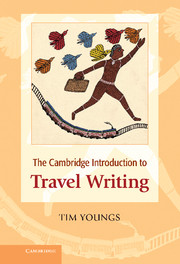Book contents
- Frontmatter
- Contents
- Figures
- Acknowledgements
- Chapter 1 Introduction
- Part I Historical overview
- Chapter 2 Medieval and early modern travel writing
- Chapter 3 Travel writing in the eighteenth century
- Chapter 4 Travel writing in the nineteenth century
- Chapter 5 1900–present
- Part II Continuities and departures
- Part III Writing and reading travel
- Notes
- Select Bibliography
- Index
Chapter 5 - 1900–present
Published online by Cambridge University Press: 05 May 2013
- Frontmatter
- Contents
- Figures
- Acknowledgements
- Chapter 1 Introduction
- Part I Historical overview
- Chapter 2 Medieval and early modern travel writing
- Chapter 3 Travel writing in the eighteenth century
- Chapter 4 Travel writing in the nineteenth century
- Chapter 5 1900–present
- Part II Continuities and departures
- Part III Writing and reading travel
- Notes
- Select Bibliography
- Index
Summary
Comes over one an absolute necessity to move.
D. H. LawrenceI was no explorer.
Paul TherouxMotors of change
Three factors have been especially dominant in the shaping of travel writing since 1900. First, ‘the Petrol Age’, as Wyndham Lewis called it in his travelogue of North Africa, has changed people’s sense of speed, their engagement with the landscape and their relationship with one another. Second, intellectual and aesthetic movements have radically influenced ideas of the self, of truth and authority, and of artistic representation. The popularisation of Freud’s concepts has resulted in the presentation of travel-narrators driven by unconscious desires and fears, producing the idea of the psychological inner journey, which will be examined in Chapter 7; and modernism and postmodernism have helped undermine the authority of a single narrative perspective. Third, the politics of ‘race’ and decolonisation, accompanied by the rise of liberation movements, have produced travel texts that challenge colonial stereotypes through the revision or reversal of colonial-era journeys.
In combination, these three phenomena contribute to the ‘conscious inter- and metatextual reflection on the conventions of travel writing’ that Barbara Korte claims is a particular feature of post-1900 travel writing. This self-consciousness is not unique to the twentieth century: we saw in Chapter 3 that it is found in eighteenth-century texts too, and we should note that even in twentieth-century travel writing only a small minority of texts ever display this self-reflection. Nevertheless, it is with these more literary texts that we are mostly concerned here. The discussion that follows will examine how their handling of narrative structure and perspective takes travel writing in new directions.
- Type
- Chapter
- Information
- The Cambridge Introduction to Travel Writing , pp. 68 - 84Publisher: Cambridge University PressPrint publication year: 2013



